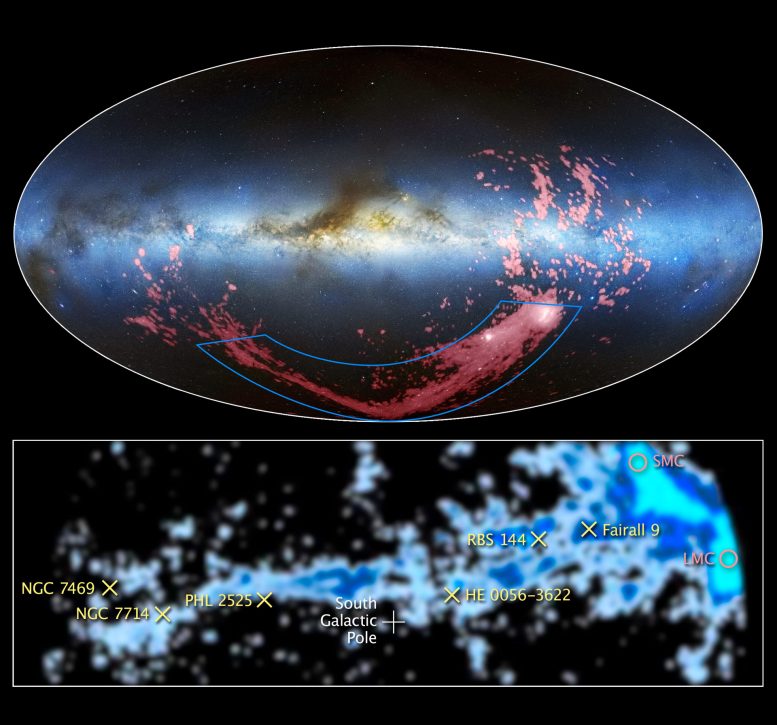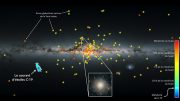
In the combined radio and visible-light image at the top, the gaseous stream is shown in pink. The radio observations from the Leiden/Argentine/Bonn (LAB) Survey have been combined with the Mellinger All-Sky Panorama in visible light. The Milky Way is the light blue band in the center of the image. The brown clumps are interstellar dust clouds in our galaxy. The Magellanic Clouds, satellite galaxies of the Milky Way, are the white regions at the bottom right.
The image at the bottom, taken at radio wavelengths, is a close-up map of the Magellanic Stream that also was generated from the LAB Survey. Researchers determined the chemistry of the gas filament by using Hubble’s Cosmic Origins Spectrograph (COS) to measure the amount of heavy elements, such as oxygen and sulfur, at six locations (marked with an “x”) along the Magellanic Stream. COS observed light from faraway quasars that passed through the stream, and detected the spectral fingerprints of these elements from the way they absorb ultraviolet light. Quasars are the brilliant cores of active galaxies. Credit: Radio/visible light image: David L. Nidever, et al., NRAO/AUI/NSF and Mellinger, LAB Survey, Parkes Observatory, Westerbork Observatory, and Arecibo Observatory. Radio image: LAB Survey
Data from the Hubble Space Telescope and ESO’s Very Large Telescope has helped solve the mystery of the origin of the Magellanic Stream, revealing that most of this stream was stripped from the Small Magellanic Cloud.
Astronomers using the NASA/ESA Hubble Space Telescope have solved the 40-year-old mystery of the origin of the Magellanic Stream, a long ribbon of gas stretching nearly halfway around the Milky Way. New Hubble observations reveal that most of this stream was stripped from the Small Magellanic Cloud some two billion years ago, with a smaller portion originating more recently from its larger neighbor.
The Magellanic Clouds, two dwarf galaxies orbiting our galaxy, are at the head of a huge gaseous filament known as the Magellanic Stream. Since the Stream’s discovery in the early 1970s, astronomers have wondered whether this gas comes from one or both of the satellite galaxies. Now, new Hubble observations show that most of the gas was stripped from the Small Magellanic Cloud about two billion years ago — but surprisingly, a second region of the stream was formed more recently from the Large Magellanic Cloud.
A team of astronomers determined the source of the gas filament by using Hubble’s Cosmic Origins Spectrograph (COS), along with observations from ESO’s Very Large Telescope, to measure the abundances [1] of heavy elements, such as oxygen and sulfur, at six locations along the Magellanic Stream. COS detected these elements from the way they absorb the ultraviolet light released by faraway quasars as it passes through the foreground Stream. Quasars are the brilliant cores of active galaxies.
The team found low abundances of oxygen and sulfur along most of the stream, matching the levels in the Small Magellanic Cloud about two billion years ago, when the gaseous ribbon was thought to have been formed.
In a surprising twist, the team discovered a much higher level of sulfur in a region closer to the Magellanic Clouds. “We’re finding a consistent amount of heavy elements in the stream until we get very close to the Magellanic Clouds, and then the heavy element levels go up,” says Andrew Fox, a staff member supported by ESA at the Space Telescope Science Institute, USA, and lead author of one of two new papers reporting these results. “This inner region is very similar in composition to the Large Magellanic Cloud, suggesting it was ripped out of that galaxy more recently.”
This discovery was unexpected; computer models of the Stream predicted that the gas came entirely out of the Small Magellanic Cloud, which has a weaker gravitational pull than its more massive cousin.
“As Earth’s atmosphere absorbs ultraviolet light, it’s hard to measure the amounts of these elements accurately, as you need to look in the ultraviolet part of the spectrum to see them,” says Philipp Richter of the University of Potsdam, Germany, and lead author on the second of the two papers. “So you have to go to space. Only Hubble is capable of taking measurements like these.”
All of the Milky Way’s nearby satellite galaxies have lost most of their gas content — except the Magellanic Clouds. As they are more massive than these other satellites they can cling on to this gas, using it to form new stars. However, these Clouds are approaching the Milky Way and its halo of hot gas. As they drift closer to us, the pressure of this hot halo pushes their gas out into space. This process, together with the gravitational tug-of-war between the two Magellanic Clouds, is thought to have formed the Magellanic Stream [2].
“Exploring the origin of such a large stream of gas so close to the Milky Way is important,” adds Fox. “We now know which of our famous neighbors, the Magellanic Clouds, created this gas ribbon, which may eventually fall onto our own galaxy and spark new star formation. It’s an important step forward in figuring out how galaxies obtain gas and form new stars.”
Notes
[1] The “abundance” of an element is a measure of how common it is in its environment relative to other elements.
[2] The Magellanic Clouds can be used as a good testing ground for theories on how galaxies strip gas from one another and form new stars. This process seems episodic rather than smooth, without a continuous, slow stream of gas being stripped away from a small galaxy by a larger one. As both of the Magellanic Clouds are approaching our own galaxy, the Milky Way, they can be used to explore the dynamics of this process.
References:
“The COS/UVES absorption survey of the Magellanic Stream: I. One-tenth solar abundances along the body of the stream” by Andrew J. Fox, Philipp Richter, Bart P. Wakker, Nicolas Lehner, J. Christopher Howk, Nadya Ben Bekhti, Joss Bland-Hawthorn and Stephen Lucas, 12 July 2013, The Astrophysical Journal.
DOI: 10.1088/0004-637X/772/2/110
arXiv:1304.4240
“The COS/UVES absorption survey of the Magellanic Stream: II. Evidence for a complex enrichment history of the stream from the Fairall 9 sightline” by Philipp Richter, Andrew J. Fox, Bart P. Wakker, Nicolas Lehner, J. Christopher Howk, Joss Bland-Hawthorn, Nadya Ben Bekhti and Cora Fechner, 12 July 2013, The Astrophysical Journal.
DOI: 10.1088/0004-637X/772/2/111
arXiv:1304.4242









It is a direct evidence of galactic cannibalism. In course of time one magellanic cloud gobbling up another one and finally to end in the Milky
Way galaxy devouring both the satelite galaxies. Thank You,
ORIGIN OF LIGHT AND SPEED OF LIGHT ?
(From my letter to Jug Suraiya)
Dear Mr. Jug Suraiya
Congratulations for your very thought provoking article ‘Einstein Won’t Mind’ (The Speaking Tree, Oct. 9, 2011, pg. 7). Einstein is great, but Newton is all time great. I would like to quote your few excellent lines from this article before I come to main theme of this article: “Faith and religious beliefs are destinations reached; science and skepticism are journeys without end”. But it’s to be modified. In Veda it is written, ‘Neti, Neti’, ‘Not this, Not this’. So in Vedic religion journey never ends. I consider Vedas the most honest scriptures which do not limit the scope of further exploration of truth. Now I come to the speed of light. This has long been proved since the time of discovery of black holes that the speed of light is not the fastest. Black holes do not allow even light to escape. It means the escape velocity at the black holes is much higher than the speed of light. Black holes are the infinitely dense ball of gravitation force. All creational forces of the universe have originated from the gravitational force field (Quantum Gravity) and will end up in it. The speed of light is no doubt fastest in our solar system. The source of light is Sun in our solar system. But how this light is originated? We should study the various stages involved in the formation of a star. Our Sun is also a star.
The starting material for the formation of a star is mainly hydrogen gas and helium gas. If the hydrogen cloud contains a very large number of atoms, each atom feels the gravitational pull of all the atoms in the hydrogen cloud. (Here is NO LIGHT)
The gas cloud becomes a permanent entity, held together by the mutual attraction of all the atoms present in it. The cloud then begins to contract under its own gravity setting off the process which will convert this huge condensed gas cloud into a star. Such a tight contracting cluster of atoms held in the grip of its own gravity, is called a protostar. The protostar is not yet a star and does NOT emit LIGHT. The temperature of this star is as low as -173 degree C.
The force of gravity acting on different atoms in the protostar draws every atom towards centre. As a result, the protostar shrinks in size and its density increases. As the atoms in the protostar fall towards the centre, they pick up speed. Because of the high speed and greater density of atoms, the atoms in the gas cloud collide with one another more frequently, thereby raising its temperature from -173 degree C to about 10 ^7 degree C. At these extremely high temperatures the proton (hydrogen nuclei) at the centre of the protostar collide together and undergo a nuclear fusion to form helium nuclei. In this reaction a tremendous amount of energy is released. This further raises the temperature and pressure. The release of nuclear energy marks the birth of the star. The protostar now beings to GLOW and becomes a STAR. Here at this stage LIGHT is ORIGINATED. Thus light is NOT ETERNAL. It has a beginning and an end. So LIGHT cannot be claimed as Cosmic Constant. However, Gravitation Force is eternal.
It is evident from the above description that light is latent before the birth of star. Light originates and become kinetic only after the action of gravitation force. So the speed of light can never exceed the speed of gravitation force. It cannot be ruled out that the speed of gravitation force is infinitely greater than the speed of light at black holes.